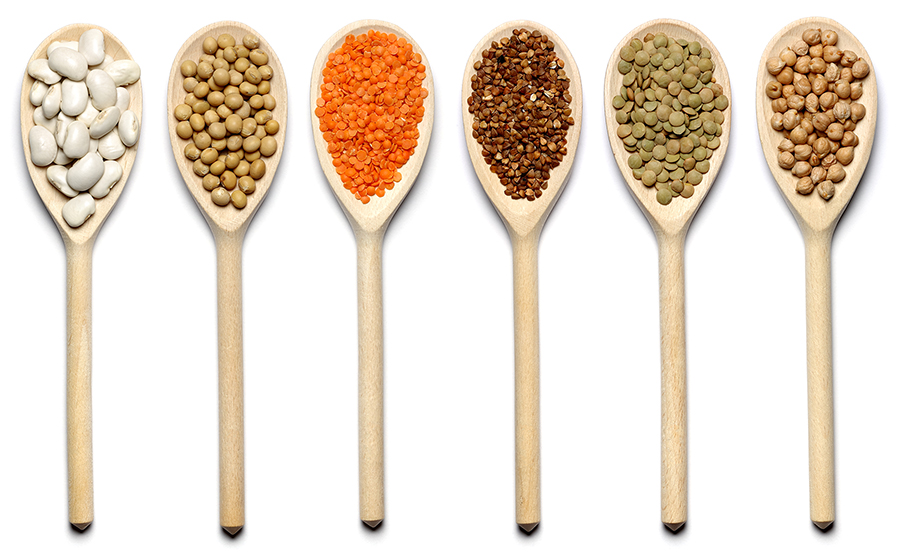Many people are struggling to find some of the staples they typically cook with. Does your family typically eat meat at most meals but now you’re having a hard time finding it? Are you thinking about adding more beans and legumes to your diet but you aren’t sure where to start? Read-on for a re-post of an article about cooking with dry beans and lentils.
Goodluck!
Rachel
If you’ve stayed away from cooking dried beans or other dry legumes like lentils or split peas because you think it is complicated, think again. Yes, they take some time, but the most effort required is filling up a pot with water and letting it simmer on the stove. Beans and legumes are economical, the dried varieties are usually around $2 for a full pound. A good source of protein, fiber, iron and folate they’re nutrition powerhouses, too.
1. Choose the right legume for what you’re cooking them for. Do you want them to soften up and fall apart in soups (lentils, split peas) or do you want them to hold their shape for salads and pastas (kidney, chickpea, black-eyed peas)?
2. Soak your beans! A good soak begins the softening process and allows the beans to cook more evenly.
3. Drain the beans from their soaking water and add to a large pot. Cover with water, about 2 inches over the top of the beans, and bring to a light boil. Turn the heat to a gentle simmer and let them cook, uncovered. Every 30 minutes, test to see if they are done. Scoop a few out and blow in them, if their skins burst and start to curl, you’re close. Most beans will cook in 45 minutes to 2 hours.
4. Seasonings add flavor and make the beans taste even better. Wait until beans are almost cooked before adding salt or anything acidic (like tomatoes). Adding salt or acid early on will strengthen the skin and make it difficult for the bean to absorb liquid. They will eventually cook, but it takes much longer.
5. Cooked beans can be stored in the refrigerator for up to one week, and they freeze well for future use. Try portioning them out in 2 cup measurements in bags and then freeze flat to save space.
Soaking dried beans begins the softening process and allows the beans to cook more evenly. Traditionally, beans are soaked overnight in cool water, giving them plenty of time to slowly absorb the liquid. But if you don’t have the time (or forgot to do it, which also happens) you can give those beans a quick soak in an hour. You never have to soak other legumes like lentils or split peas.
Adzuki: These small, scarlet beans are sweet and cook quickly. They’re often used in Japanese bean paste desserts, but are versatile enough for salads, soups and stews.
Black: Also known as turtle beans, these full-flavored beans are classic in Latin American cooking, usually for soups and stews.
Black-eyed peas: These small earthy-flavored beans, also known as crowder peas and cowpeas, are particularly cherished in Southern cooking.
Cannellini: These mild, starchy white beans are often used in soups and stews, particularly in Italian cooking.
Chickpeas: These nutty-tasting legumes, also known as garbanzo beans, are used all the globe in many guises: soups, stews, dips and even fried or roasted as a snack.
Cranberry: These red-and-brown speckled beans have a rich, toasty flavor. They hold their shape well for salads, soups and stews.
Fava: Dried favas, also known as broad beans, have a very strong, meaty flavor and a somewhat thick skin. Beloved in Middle Eastern cuisine, they are made into soups, stews and salads.
Flageolet: These are a creamy, smooth, pale green-to-white-hued bean from France with a thin skin. They work well for soups and purées.
Great Northern: These large white beans with a firm texture and gentle, nutty flavor are great for stews and soups.
Kidney: These large red beans are often used in salads and chili. Some people find them particularly hard to digest, but soaking and rinsing before cooking can help, as does using a pressure cooker.
Lentils: There are several varieties of these tiny legumes, ranging from shiny black beluga lentils, which remain nicely intact for salads, to orange-hued “red” lentils, which collapse into a thick purée when simmered. In between, there are brown lentils (good all-purpose lentils) and more expensive French green lentils, also called Puy lentils, which take a bit longer to cook and have a nice sweet flavor. All lentils are relatively quick-cooking and don’t need any presoaking.
Lima: Large white dried lima beans take on a velvety, creamy texture after simmering, and hold their shape well.
Navy: These small white beans have a nutty flavor, and cook more quickly than other white beans. They are the traditional choice for Boston baked beans. Like red kidney beans, they can be easier to digest if you soak and rinse before cooking.
Pinto: These are small brownish-pink beans frequently used in Mexican and other Latin American cooking, particularly for refried beans, stews and chili.
Split peas: Green or yellow split peas are small legumes often used in soups, and in the case of the yellow ones, Indian dals. They do not need to be soaked before cooking.
Add any non-acidic flavor to the pot before cooking, it will impart the flavor into the bean. Sauteed onions and garlic are a standard combination for most bean varieties, and most herbs go well with beans. Try one of these combos:
- Bay leaf, carrot and sage
- Cumin and ginger
- Rosemary, garlic and thyme
- Black pepper, basil and oregano
Written by Adriene Worthington, RDN, LDN


